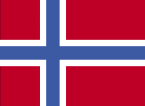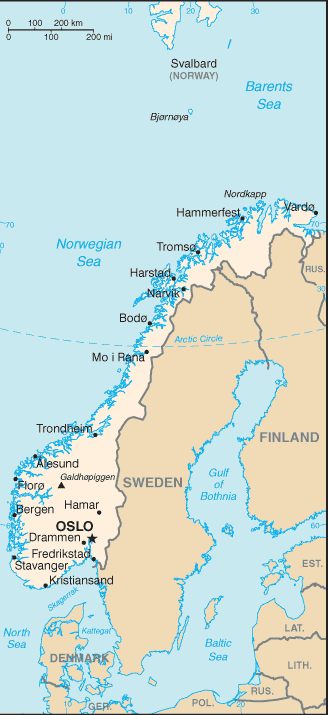|
Norway
|

|
Capital: Oslo
Population: 5,378,857
Brief History of Norway:
The history of Norway is perhaps most famous for its Viking Age which lasted from the 9th to the 11th centuries. The Viking era began in the late 800s when the first Viking King Harald Fairhair unified the Vikings into a single nation. The Vikings were a seafaring people who expanded their territory and raided northern Europe. The Vikings settled much of Greenland and parts of Britain and Ireland. In the 11th century, Olav I became the first Christian king of Norway. He converted much of Norway to Christianity during his reign.
In 1397 Norway united with Denmark and Sweden under the Kalmar Union. Sweden broke from the union in 1521, but by 1586 Norway was part of the Danish Kingdom. After the Napoleonic wars, Norway was taken from Denmark and combined with Sweden under the Treaty of Kiel in 1814. In 1905, Norway became an independent country again.
Norway remained neutral in World War I, but was occupied by the Germans in World War II. After the war, Norway became a founding member of the United Nations. Norway is not a member of the European Union.
The Geography of Norway
Total Size: 323,802 square km
Size Comparison: slightly larger than New Mexico
Geographical Coordinates: 62 00 N, 10 00 E
World Region or Continent: Europe
General Terrain: glaciated; mostly high plateaus and rugged mountains broken by fertile valleys; small, scattered plains; coastline deeply indented by fjords; arctic tundra in north
Geographical Low Point: Norwegian Sea 0 m
Geographical High Point: Galdhopiggen 2,469 m
Climate: temperate along coast, modified by North Atlantic Current; colder interior with increased precipitation and colder summers; rainy year-round on west coast
Major cities: OSLO (capital) 875,000 (2009), Bergen, Trondheim
The People of Norway
Type of Government: constitutional monarchy
Languages Spoken: Bokmal Norwegian (official), Nynorsk Norwegian (official), small Sami- and Finnish-speaking minorities; note - Sami is official in six municipalities
Independence: 7 June 1905 (Norway declared the union with Sweden dissolved); 26 October 1905 (Sweden agreed to the repeal of the union)
National Holiday: Constitution Day, 17 May (1814)
Nationality: Norwegian(s)
Religions: Church of Norway 85.7%, Pentecostal 1%, Roman Catholic 1%, other Christian 2.4%, Muslim 1.8%, other 8.1% (2004)
National Symbol: lion
National Anthem or Song: Ja, vi elsker dette landet (Yes, We Love This Country)
Economy of Norway
Major Industries: petroleum and gas, food processing, shipbuilding, pulp and paper products, metals, chemicals, timber, mining, textiles, fishing
Agricultural Products: barley, wheat, potatoes; pork, beef, veal, milk; fish
Natural Resources: petroleum, natural gas, iron ore, copper, lead, zinc, titanium, pyrites, nickel, fish, timber, hydropower
Major Exports: petroleum and petroleum products, machinery and equipment, metals, chemicals, ships, fish
Major Imports: machinery and equipment, chemicals, metals, foodstuffs
Currency: Norwegian krone (NOK)
National GDP: $265,500,000,000
** Source for population (2012 est.) and GDP (2011 est.) is CIA World Factbook.
Back to Geography Home Page
